
![]()
BACKGROUND – TALKING POINTS – ACTIONS – STORIES
![]()

Relief and dread descended over Israelis with the latest release of three Israeli hostages by Hamas in exchange for 90 Palestinian prisoners. The release of innocent hostages – held under inhumane conditions – comes at the heavy cost of freeing convicted terrorists, including murderers. This choice highlights Israel’s unyielding commitment to the sanctity of human life, even at a heavy cost and great risk. This is not just a transaction, but a profound reflection of Israel’s moral clarity in the face of an enemy that weaponizes human suffering – prioritizing saving the lives of hostages over the need to destroy Hamas.
The Gaza ceasefire comes while terrorist attacks continue almost daily within Israel. A Moroccan national and U.S. permanent resident stabbed four Israelis in Tel Aviv before being shot dead. Three days earlier, a Palestinian stabbed an Israeli in Tel Aviv before being shot dead. In the West Bank, the Israeli Defense Forces launched Operation Iron Wall to destroy terrorist infrastructure in the Palestinian city of Jenin – a major hotbed of terror and hate.
Suffering of the Hostages: ‘I thought I’d die in Gaza’
The first freed hostages revealed an unimaginable ordeal. For 471 days, these young women – Romi Gonen, 24, Emily Damari, 28, and Doron Steinbrecher, 31 – faced physical deprivation, psychological torment and complete uncertainty about their fates. They returned malnourished, traumatized and in need of extensive care. Emily held up her hand that was missing two fingers, shot off on 10/7 by a Hamas gunman. Smiling and defiant when reunited with their families, Romi declared: “Dad, I came back alive!”
We are beginning to hear their initial testimonies: “We were scared to death at the transfer point on 10/7, from the combination of the armed terrorists and the Gazan crowd. But we heard our families fighting for us even though I didn’t think I would come back. I thought I’d die in Gaza.” They did not know they were being released until a few hours before. Romi was kidnapped from the Nova music festival and the other two were abducted from their homes. They were moved around several times, including in tunnels, civilian homes and humanitarian zones. This validates reports from the IDF that Hamas endangered the civilian locations where the hostages were held.
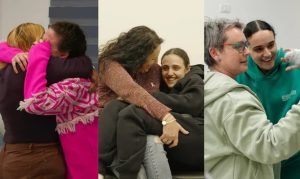
For the past 15 months, families of the hostages have suffered their own form of torture. Sleepless nights, unanswered questions and relentless advocacy have defined their lives. The families have been on a roller coaster of emotions as they celebrate the hostage deal while waiting to learn if and when their relatives will be released – and if they are even alive.
Hamas confirmed it will release four more female hostages on Saturday, Jan. 25, without naming them. Israeli special forces recently retrieved the body of soldier Oron Shaul – Hamas terrorists killed him in 2014 and abducted his body to Gaza. He was laid to rest the day after the three latest hostages returned home.
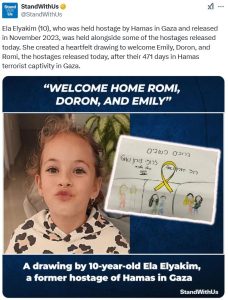
Hostages for Terrorists: ‘Our moral, Jewish and Israeli Obligation’
Israelis pay an unprecedented price in exchange for securing the release of its hostages. Each Israeli is being traded for dozens of Palestinian security prisoners, many sentenced for committing terror attacks against Israelis of all religions and ethnicities.
Israelis are embracing the Jewish principle of pikuach nefesh – saving a life. Israeli President Isaac Herzog: “I harbor no illusions – the deal will bring with it great challenges and painful, agonizing moments that we will need to overcome and face together. There is no greater moral, human, Jewish or Israeli obligation than to bring our sons and daughters back to us.”
While there have been protests and legal challenges against releasing the terrorists, according to most surveys, a majority of Israelis favor the deal. The exchange forces Israelis who lost their loved ones to balance their grief with the gain of returning hostages. Israeli news anchor Yair Shriki found out that the terrorist who killed his brother will be released: “It’s unbearable, but my brother is gone, and Romi Gonen is still alive.” Romi’s mother, celebrating the return of her daughter from captivity: “Family never gives up, and the people of Israel are family.”
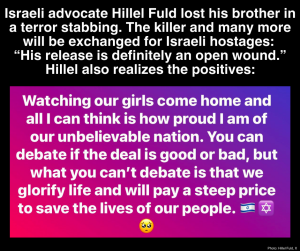
Hamas Psychological Terror Continued Until the Last Second
The video of the hostages being transferred from Hamas to the Red Cross were jarring. The three young Israeli women were surrounded by dozens of armed fighters – wearing masks and Hamas uniforms rather than their usual civilian clothing. Dozens of jubilant Palestinian civilians rallied behind the gunman while recording the hostages on their cell phones amid the chaos. Hamas terrorists had the audacity to give each hostage a ‘goodie’ bag with photos from their confinement, presented each of them with a certificate for their captivity – signed by a Red Cross representative – and forced them to wear necklaces with Palestinian flags. The Red Cross drove them away in vans with windows that allowed Gazans to continue to heckle them. Only once they entered Israel did IDF soldiers embrace them before they were reunited with their families.
The 90 Palestinian security prisoners released by Israel were met with boisterous celebrations and were greeted by supporters waving Hamas and Hezbollah terrorist flags. Hamas and its supporters around the world declared victory in Gaza after the ceasefire was announced, furthering its propaganda goals.

Three-Phase Deal: Will it Proceed?
A senior Hamas ‘political’ leader told Al-Jazeera on Oct. 7 while the attacks were still ongoing: “We have enough hostages in our hands for Israel to release all our prisoners. The longer fighting continues, the higher the number of prisoners will become.” Israel’s acceptance of Hamas demands has been described as a deal with the devil – the same devil that is sacrificing the lives of its own citizens while proudly claiming they will repeat Oct. 7 again and again.
Hamas and Israel agreed and have started to implement the first stage of an outlined three-phase deal. The terror group will first release female, older and injured hostages in slow drips once a week for seven weeks. In this first phase, Hamas committed to releasing 33 of the 98 hostages – not all living – in return for about 1,900 Palestinian prisoners. The first phase of the 42-day agreement includes a ceasefire. Israel maintains its right to protect its troops, will withdraw Israeli forces from certain areas within Gaza, and Palestinian civilians will return to their neighborhoods. The agreement includes an increase in humanitarian aid entering Gaza – much already being confiscated by Hamas.
Only the first phase has been signed, the next two stages remain subject to negotiations. The goals for phase two include the release of the remaining living hostages for more terrorists. A full withdrawal of Israeli forces is contingent upon Hamas agreeing to remove itself from power. Many experts and President Trump are “not confident” the deal will hold because Hamas has refused to relinquish power to the Palestinian Authority or a consortium of Arab nations suggested as alternatives. Israeli leaders reportedly approved the deal in exchange for American guarantees that Hamas will not be allowed to rule Gaza again. The final phase focuses on returning the remains of deceased hostages, reconstruction efforts and peace initiatives.
Every hostage remaining in Gaza has their own story – from the oldest remaining hostage, Shlomo Mansur, 86, born in Iraq, to the youngest, Kfir Bibas, kidnapped at 9-months-old. Many have relatives who were killed on Oct. 7 and others have relatives that were released more than a year ago. Many are injured. Three have been held for more than a decade – Hisham Al-Sayed, Avera Mengistu and Hadar Goldin. Surasak Lamnau is one of nine remaining Thai nationals working on Israeli farms when they were kidnapped. Of the remaining hostages, 36 are confirmed to be dead.
Blood on Their Hands: A Rapist Killer, the ‘Bedtime Butcher’ and Others to be Freed
The “bedtime butcher” stormed into the kibbutz home of Revital Ohayon as the young mother read a bedtime story to her two sons, Noam and Matan, in 2002. The terrorist opened fire, instantly killing the mother and her four-year-old and five-year-old sons clutching their bed covers over their heads. The kibbutz was considered a model of co-existence between Jews and Arabs. That bedtime butcher, a Fatah terrorist, is slated to be released.
Arafat Irfaiya pled guilty to the rape and murder of 19-year-old Israeli Jew Ori Ansbacher in 2019. Ori – a volunteer at a Jerusalem youth center – was walking in the Jerusalem Forest. The Hamas terrorist stabbed her multiple times because “I wanted to become a martyr and murder a Jew.” Instead, he was sentenced to life in prison plus 20 years – until now. International women’s and human rights groups are deafeningly silent.
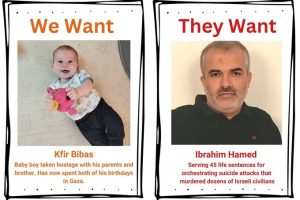
The terrorists with ‘blood on their hands’ belong to multiple terror groups, including Iran-backed Hamas, Iran-backed Palestinian Islamic Jihad and Fatah – the ruling party of the Palestinian Authority. Other murderers slated for release:
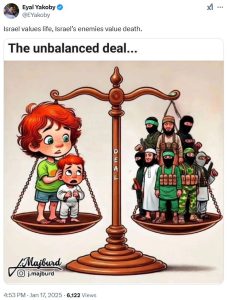
Hamas and SJP: More 10/7 Attacks Until Israel is Destroyed
The Iran-backed terror group prioritizes propaganda over human life. Hostages are not merely prisoners, but tools of psychological warfare wielded to manipulate public opinion and sow fear. Immediately following the ceasefire announcement, a senior Hamas official proudly proclaimed that the Oct. 7 atrocities are a “source of pride that dealt the enemy a deadly blow and we will continue our jihad and our resistance.” The anti-Israel university organization National Students for Justice in Palestine announced: “Let’s continue to support mutual aid efforts and organize to eradicate Zionism on our campuses. Our work has only just begun.” Protesters in NYC also called for more attacks.
![]()

![]()

A. Become an influencer: Use our messaging to spread awareness > Use the facts in the Background and the Talking Points to help amplify the stories of the released hostages, their families and the continuing evil actions committed by Hamas – against Palestinians and Israelis. Whether you are talking with family, friends or coworkers, or posting on social media, help reach and teach someone who does not have a full understanding of the issues vital to the Jewish community.
B. Verify what you read, see and hear > Do not blindly trust sources of information including photos and video that might be influenced by biased individuals and organizations engaged in their own war against America and Israel. This may even include journalists who should adhere to verifiable, factual reporting, ensuring balanced and accurate coverage. When you come across misinformation in the news, consider correcting it via a letter to the editor of a newspaper, the comment section of a post or by tagging an organization on social media. Media reporting watchdogs include HonestReporting and CAMERA (Committee for Accuracy in Middle East Reporting and Analysis).
C. Stay informed and educated
American Jewish News sources:
Israeli News Sources (in English):
Two resources, Wikipedia and ChatGPT, have demonstrated anti-Israel bias and dependence on pro-Palestinian information sources, and entries should not be presumed impartial or accurate.
![]()

The word “ceasefire” was mentioned more than 3.1 million times on social media in the past week in response to the ceasefire and hostage deal that was signed between Hamas and Israel last week. The announcement of the agreement led to a 148% increase in social media conversations.
Data courtesy of the Foundation to Combat Antisemitism, which publishes a weekly newsletter related to its campaign #StandUpToJewishHate 🟦 at https://www.fcas.org/newsletter/
![]()

Havard Reaches Agreement with Brandeis Center to Settle Lawsuit
The Louis D. Brandeis Center for Human Rights Under Law and Jewish Americans for Fairness in Education filed a federal lawsuit on behalf of Harvard students in May for years of “cruel antisemitic bullying, harassment and discrimination.” The prestigious Ivy League school recently agreed to a major settlement.
Harvard’s existing Non-Discrimination and Anti-Bullying Policies, which prohibit discrimination based on ancestry, religion, national origin, or political beliefs, will be updated to incorporate the International Holocaust Remembrance Alliance definition of antisemitism, including examples issued by the Dept. of Education’s Office for Civil Rights. Harvard will use the IHRA definition and examples when evaluating complaints of anti-Jewish discrimination and harassment.
Harvard will take additional steps, including recognizing that “for many Jewish people, Zionism is a part of their Jewish identity. Conduct that would violate the Non-Discrimination Policy if targeting Jewish or Israeli people can also violate the policy if directed toward Zionists. Examples include excluding Zionists from an open event, calling for the death of Zionists, applying a ‘no Zionist’ litmus test for participation in any Harvard activity, using or disseminating tropes, stereotypes and conspiracies about Zionists (e.g., ‘Zionists control the media’), or demanding a person who is or is perceived to be Jewish or Israeli to state a position on Israel or Zionism to harass or discriminate.”
Stories Impacting American Jews
Stories Impacting the U.S. and Israel
Stories From Around the World
![]()
In light of the surge of current relevant news, please subscribe to our Daily News Brief, a digest of critical news headlines curated from thousands of media addressing issues that affect the Jewish world.
![]()

This content is developed by The Focus Project in partnership with MERCAZ USA. The Focus Project distributes weekly news and talking points on timely issues concerning Israel and the Jewish people, including antisemitism, anti-Zionism and the delegitimization of Israel. It represents a consensus view across a spectrum of major American Jewish organizations. MERCAZ USA recognizes and respects the diversity of views on these issues among its readers and the community at large.
![]()